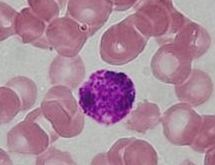| Basopenia | |
|---|---|
 | |
| A peripheral blood basophil stained with a Romanovsky stain. | |
| Specialty | Hematology |
Basopenia (or basocytopenia) is a form of agranulocytosis associated with a deficiency of basophils. [1] It has been proposed as an indicator of ovulation. [2] It is difficult to detect without flow cytometry, because normal levels are so low. [3] It can be defined as less than 0.01 billion / L. [4] Basopenia has been observed in a number of conditions, including after the administration of corticosteroids and in disease states such as chronic urticaria and lupus. [5]